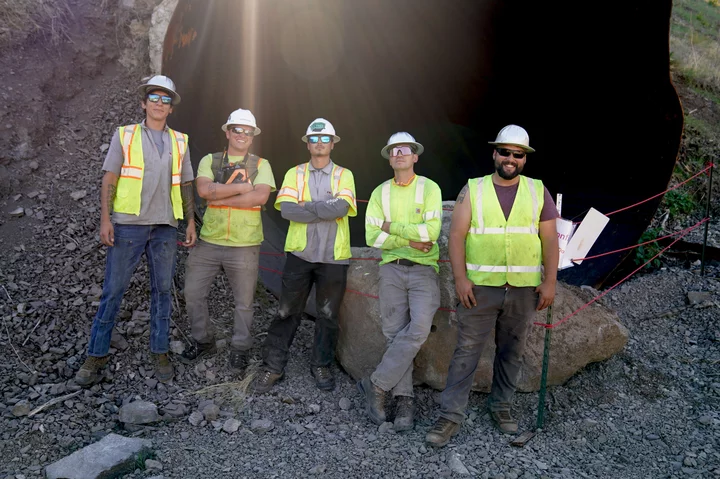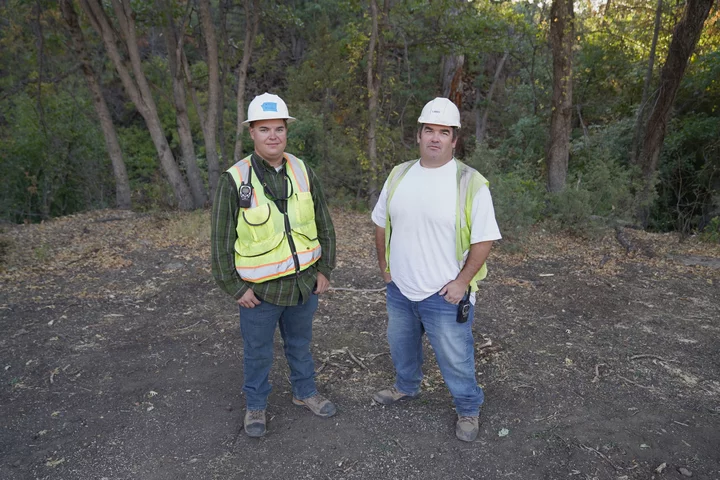WRO Staff / Monday, Sept. 18, 2023 @ 11:45 a.m.
Yurok Tribe and Others are Preparing a Stretch of the Klamath River to Flow Freely for the First Time in a Century
Above: Revelers from this past weekend's North Country Fair on the Arcata Plaza enact a whimsical dramatization of Klamath dam removal.
The following members of the Yurok Tribe Construction Corporation participated in the Kikacéki Project: (L-R) Brandon Colegrove, Will Bowers, Tahn Blake, Nolan Colegrove and Temptation Asenbauer. | Submitted.
Press release from the Yurok Tribe:
The Yurok Tribe and the Klamath River Renewal Corporation (KRRC), in collaboration with the Shasta Indian Nation, recently started preparing a stretch of the Klamath River to flow freely for the first time in a century.
The soon-to-be dismantled Klamath Hydroelectric Project has blocked fish passage and altered river flows for over 100 years. In Kikacéki, a place sacred to the Shasta Indian Nation, there is an area commonly known as Ward’s Canyon where the river has lacked consistent flows for nearly a century. In 1925 the construction of Copco No. 2 dam was completed, diverting the river into a tunnel that traveled nearly 2 miles downstream to a powerhouse, dewatering the historic reach of river canyon.
In the absence of sustained river flows, a dense stand of trees colonized the riverbed within the steep canyon. The Yurok Tribe Construction Corporation and Yurok Fisheries Department, in coordination with KRRC, Shasta Indian Nation, and HeliDunn, a locally owned helicopter company, are clearing the alder and cottonwood trees from the river corridor, while leaving all floodplain vegetation intact. The trees are being transported to a staging location for later use in the restoration of the 2,200 acres of reservoir beds that will be exposed after drawdown is complete.
“It fills my heart to know that salmon will migrate through this river reach on their way to spawn in the upper basin,” said Yurok Vice Chairman Frankie Myers. “For the last century, we have watched the dams suffocate the life out of the river and it has negatively impacted every member of our tribe. I would like to thank the KRRC and the Shasta Indian Nation for the opportunity to help our salmon runs and our river recover for our children and the next generations.”
Located within the traditional homeland of the Shasta Indian Nation, Kikacéki connects traditional villages, important ceremonial places, and the Tribe’s spiritual center of the world. Archaeological evidence shows that the area has been inhabited for thousands of years—until construction of the Copco dams began. During the dams’ construction, Shasta people living there also had their lands taken by eminent domain. Yet, the canyon and the river remain of immense cultural importance to the Shasta people, who continue to come up the Canyon every year to see their former home from the roadside.
“My family is from Kikacéki. I feel at peace whenever I come up here. I know as a Shasta Indian that I'm home. I want others to understand and appreciate why this land and the river is so important for us. We are happy to collaborate with the Yurok Tribe and KRRC on this part of the project. It is good that Tribal people are working in this area,” said Shasta Indian Nation Councilman Mike Olson.
Prior to project implementation, the 1.7-mile-long reach was surveyed to identify trees for removal up to the expected 3,000 cfs line. The hazard tree removal project is being implemented over the course of approximately two months. Destined to perish after the river reclaims its natural path, the trees need to be cleared to make it safe for whitewater rafters, kayakers, and boat-based anglers to navigate the river after the dams come down.
The Klamath dam removal project broke ground in June 2023, after the Federal Energy Regulatory Commission (FERC) issued the approval that allowed construction crews to get to work on the deconstruction of Copco No. 2 dam. Copco No. 2 will be fully removed by the end of September. Iron Gate, JC Boyle and Copco No. 1 dams will be deconstructed next year in what is considered the largest salmon restoration project in history. The Klamath River Renewal Corporation, a nonprofit organization formed by signatories of the amended Klamath Hydroelectric Settlement Agreement, is overseeing the monumental project.
“We would not have reached this point if it were not for the long-standing advocacy of the tribal communities along the Klamath River,” said Mark Bransom, CEO of the Renewal Corporation “Seeing the revitalization of this river canyon is incredible, and we are honored to collaborate with the Yurok Tribe and Shasta Indian Nation on this portion of the project.”
Prior to construction of the dams, the Klamath supported 1 million spring and fall Chinook or king salmon as well strong populations of steelhead trout, sturgeon, Pacific lamprey and many other native fish species, all of which are struggling. This fall, fisheries managers predict that less than 25,000 Chinook will return to the river. Spring salmon stocks are equally dismal. In response to the decline in fish numbers, the Yurok Tribe cancelled its annual salmon harvest to protect fish. Non-tribal commercial and recreational salmon fisheries in California were also closed this summer due to the weak fish run.
The decline of the Klamath’s once prolific salmon populations is attributed to several factors, but the Klamath dams are by far the single biggest impediment to fish production. After the dams are removed, fisheries experts expect fish numbers to gradually increase in response to renewed access to historic spawning grounds, a reduction in disease exposure and improved ecosystem health.
“It is important to me that my children and future generations have a free-flowing Klamath River to preserve our culture and traditions,” said Shasta Indian Nation Vice-Chair Candice Difuntorum. “We have a saying in Shasta—rawé·ki ča·k’ú t’árak. It means ‘may the land be returned.’ For the wellbeing of the land and our people, we look forward to the day that Kikacéki is restored”
###
Yurok Tribe
With more than 6,400 enrolled members, the Yurok Tribe is currently the largest tribe in California. The Tribe’s major initiatives include fisheries restoration, protection, and management, Klamath dam removal, condor reintroduction, holistic forest management, cultural preservation, sustainable economic development and land recovery.
Klamath River Renewal Corporation
The Klamath River Renewal Corporation, or KRRC, is a private, independent nonprofit 501(c)(3) organization formed by signatories of the amended Klamath Hydroelectric Settlement Agreement, or KHSA. KRRC is part of a cooperative effort to re-establish the natural vitality of the Klamath River so that it can support all communities in the Basin. Signatories of the amended KHSA, including the States of California and Oregon, local governments, Tribal nations, dam owner PacifiCorp, irrigators, and several conservation and fishing groups, appointed KRRC to take ownership and oversee removal of four hydroelectric dams on the river.
Shasta Indian Nation
With approximately 300 enrolled members, the Shasta Indian Nation is the Tribe whose homelands included Kikacéki. The ancestors of all its present members lived at Kikacéki prior to the construction of the Copco dams. Today, the Tribe’s major initiatives are focused on cultural preservation, language education, and land return.
Tribal Cultural Monitors (L-R) Willis Hindle and Larry Leonard from the Shasta Indian Nation were hired to survey the treatment area prior to and after project implementation. | Submitted.


CLICK TO MANAGE